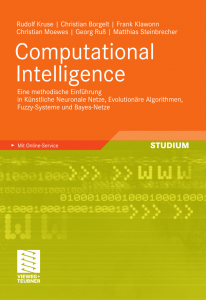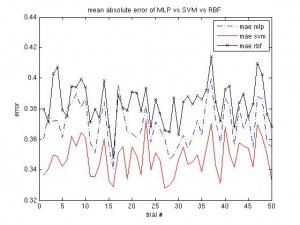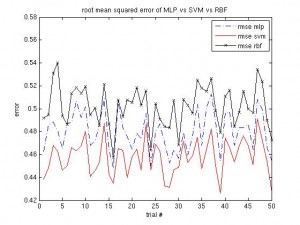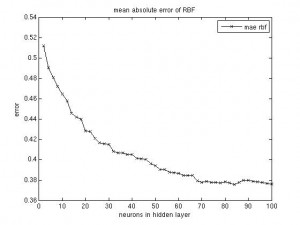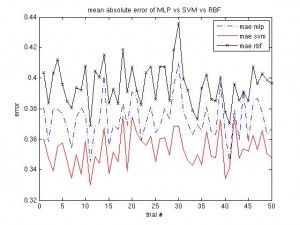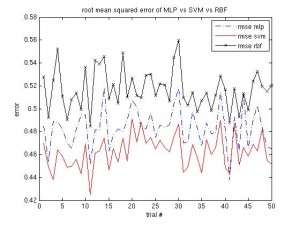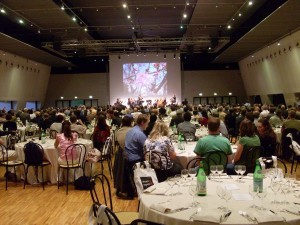In the previous article on the MLP vs. SVM vs. RBF comparison the RBF performed worse than the other two. Well, even after doing some optimisation on the RBF parameters (hidden layer size), it is still continuously worse than SVM and MLP, although the margin is smaller.
Seiten
Kategorien
- agriculture
- conferences
- data mining
- Deutsch
- English
- Environmental Data Mining
- go8-coop
- ICDM 2008
- ICDM 2009
- ICDM 2010
- ICDM 2011
- ICPA 2010
- IDA 2009
- IDA 2010
- IEEE-ICDM10
- IFCS 2009
- IFIP AI-2008
- IPMU 2008
- IPMU 2010
- MLDM 2009
- neuroscience
- personal
- R
- SGAI AI-2007
- SGAI AI-2008
- SGAI AI-2009
- sports science
- Uncategorized
Our recent book
 Data Mining et al — RSS feed
Data Mining et al — RSS feedMeta
Update: MLP vs. SVM vs. RBF
RBF parameters
Since the size of the hidden layer of the RBF network seems to be the most important parameter, I’ve run a short simulation that outputs a graph for the network’s performance (mae, rmse), plotted against the hidden layer’s size. As expected, the curve turns out flat with larger numbers of neurons. A good tradeoff seems to fix the size at 70 neurons (for the given data set, of course).
(I could have plotted them into one figure, but I was too lazy to change the script.)
I’d like to mention that the cross validation partitioning step was done just once and the network’s parameter was varied just for this one data split. This might be a problem, but, as we saw in the previous post, the three models I’ve trained all perform similar, with similar ups and downs in performance over different data partitions. It therefore should be justified to run the RBF parameter experiment just on one split.
MLP vs. SVM vs. RBF
Yet another neural network, the radial basis function (RBF) network was used as a function approximation to compare against the MLP and SVM models. The parameter settings for the RBF have not been optimised so far. I simply ran it against the MLP/SVM on the same cross validation data. The results can be obtained from the following two graphics:
The script for the above graphics is online.
At the moment I’m running some simulations to determine the size of the hidden layer of the RBF network, as this seems to be the most important parameter. The matlab implementation of the RBF network also takes some time to incrementally add neurons up to a maximum number (user-specified).
Impression from WCC 2008
This World Computer Congress 2008 in Milano, Italy, is huge. The gala dinner in the large Milano Convention Centre’s Auditorium seated roughly 1,000 people. Even if there were only 800 there, it still is massive and impressive.
Leaving for IFIP-AI 2008 at Milano, Italy
We’ll be leaving tomorrow morning for IFIP-AI 2008 in Milano, Italy. The conference is part of the World Computer Congress. My talk will be on Monday afternoon and I’m going to be chairing my own session there (.pdf program). The slides (.pdf, 1.1MB) are slightly different from the ICDM ones since the work differs slightly, too. Upon returning from this conference, I’ll start working again at University, even though I’m technically still on vacation. There is also the structure of my PhD thesis that needs to be written down which I’ll probably do next week.
Correlation between conference attendees and number of questions
This is more of a quick idea that arose when I thought of the correlation between the size of the conference and the number of serious questions that were asked right after my respective talks. For me, the plot looks as follows:
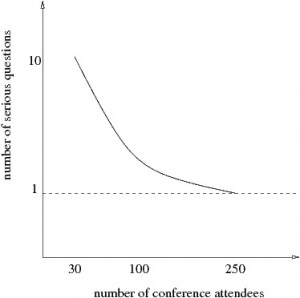
(Your mileage may vary!)
Back from ICDM 2008 in Leipzig
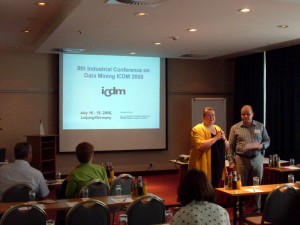 The 8th Industrial Conference on Data Mining, held in Leipzig, was clearly the most worthwile conference for me so far. There were no parallel sessions, I was able to talk for about 30 minutes, presenting the paper from the proceedings as well as some things that would otherwise have been future work. And, most important, I had immediate and massive feedback: roughly ten questions right at the end of my talk and another one or two hours of discussion with other authors during the breaks or the socializing events. Moreover, I even understood most of the other talks and was interested in hearing them which was not quite the case for the recent IPMU conference. If I have some interesting work to show, I will clearly apply for next year’s ICDM, too.
The 8th Industrial Conference on Data Mining, held in Leipzig, was clearly the most worthwile conference for me so far. There were no parallel sessions, I was able to talk for about 30 minutes, presenting the paper from the proceedings as well as some things that would otherwise have been future work. And, most important, I had immediate and massive feedback: roughly ten questions right at the end of my talk and another one or two hours of discussion with other authors during the breaks or the socializing events. Moreover, I even understood most of the other talks and was interested in hearing them which was not quite the case for the recent IPMU conference. If I have some interesting work to show, I will clearly apply for next year’s ICDM, too.
Read the rest of this entry »
Leaving for ICDM2008
From tomorrow for the rest of this week I’ll be commuting from Magdeburg to Leipzig for visiting ICDM 2008. The conference audience is probably smaller than the IMPU 2008 audience, there are no parallel sessions and only 33 talks distributed over three days. The talks are also longer (up to 30min total time), which made me extend my talk by our work in progress using self-organizing maps because it runs along the same lines and uses the ideas that are in the paper submitted to ICDM 2008. I’ll publish the current version of the slides via the following link (and update, if necessary): http://iws.cs.uni-magdeburg.de/~russ/scientificwork/slides/slides-2008icdm.pdf. My talk will be the fourth on Wednesday morning, right before the coffee break.
Back from IPMU 2008
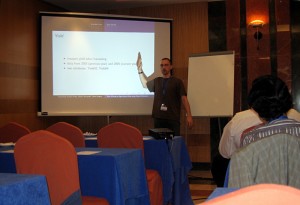
As noted in the previous blog post, last week I attended IPMU 2008. My presentation that featured the work done with the agriculture data went smoothly. There was a guy from Caterpillar who had his talk right before mine who was very aware of what I was doing and definitely knew what I was talking about. I asked him afterwards and it turned out that he grew up on a farm. I still need to study some American accents because I don’t know exactly where to put him. There were a lot of other presentations and (at least at the gala dinner) around 250 participants with (at most) five parallel sessions which is a lot of research work in a very short time.
Read the rest of this entry »
Slides / talk information IPMU 2008
My final slides for IPMU 2008. My presentation is scheduled for Thursday, June 26th, in the „Applications II“ section. The corresponding paper can be downloaded at our working group’s publication database.
Data Mining et al is powered by WordPress | Using Tiga theme with a bit of Ozh + WP 2.2 / 2.3 Tiga Upgrade
